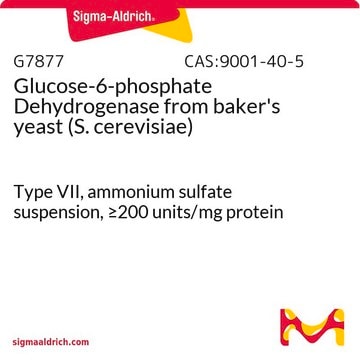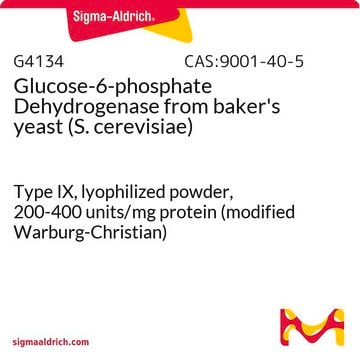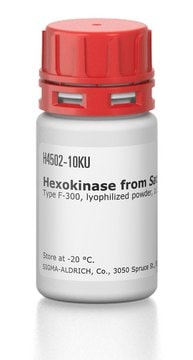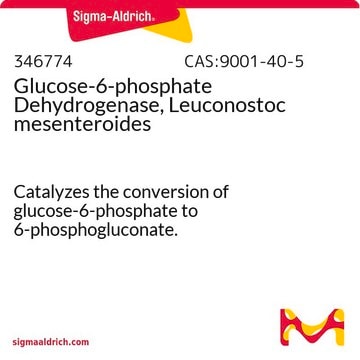To reconstitute dissolve G6378, Glucose-6-phosphate Dehydrogenase, in water and a dilute buffer. Following reconstitution, it should be refrigerated at 4°C, with stock solutions remaining stable for up to 6 months at this temperature.
G6378
Glucose-6-phosphate déshydrogénase from baker′s yeast (S. cerevisiae)
Type XV, lyophilized powder, 200-400 units/mg protein (modified Warburg-Christian)
Synonyme(s) :
G-6-P-DH, Zwischenferment
About This Item
Produits recommandés
Type
Type XV
Niveau de qualité
Forme
lyophilized powder
Activité spécifique
200-400 units/mg protein (modified Warburg-Christian)
Poids mol.
128 kDa
Produit purifié par
crystallization
Application(s)
diagnostic assay manufacturing
Conditions d'expédition
dry ice
Température de stockage
−20°C
Vous recherchez des produits similaires ? Visite Guide de comparaison des produits
Catégories apparentées
Description générale
Application
Actions biochimiques/physiologiques
Définition de l'unité
Forme physique
Notes préparatoires
Mention d'avertissement
Danger
Mentions de danger
Conseils de prudence
Classification des risques
Resp. Sens. 1
Code de la classe de stockage
11 - Combustible Solids
Classe de danger pour l'eau (WGK)
WGK 3
Point d'éclair (°F)
Not applicable
Point d'éclair (°C)
Not applicable
Équipement de protection individuelle
Eyeshields, Gloves, type N95 (US)
Faites votre choix parmi les versions les plus récentes :
Certificats d'analyse (COA)
Vous ne trouvez pas la bonne version ?
Si vous avez besoin d'une version particulière, vous pouvez rechercher un certificat spécifique par le numéro de lot.
Déjà en possession de ce produit ?
Retrouvez la documentation relative aux produits que vous avez récemment achetés dans la Bibliothèque de documents.
Les clients ont également consulté
Protocoles
To measure glucose-6-phosphate dehydrogenase activity, beta-nicotinamide adenine dinucleotide phosphate is used in a spectrophotometric rate determination assay at 340 nm.
-
What are the recommended reconstitution and storage procedures for item G6378, Glucose-6-phosphate Dehydrogenase from baker's yeast (S. cerevisiae)?
1 answer-
Helpful?
-
-
What is the activity and protein content of the lot number of Product G6378, Glucose-6-phosphate Dehydrogenase, I have?
1 answer-
The protein content and the specific activity of the enzyme can be found on the lot-specific certificate of analysis.
Helpful?
-
-
What does Type XV mean in the description of Product G6378, Glucose-6-phosphate Dehydrogenase?
1 answer-
The type designation Type XV is a Sigma in-house designation and does not represent any kind of biochemical significance. It simply refers to the order of addition of the product to the catalog (i.e., first there was a type I, then a type II, etc.).
Helpful?
-
-
What are the Km values for Product G6378, Glucose-6-phosphate Dehydrogenase?
1 answer-
The Km values for glucose 6-phosphate and NADP are 2.0 x 10-5 and 2.0 x 10-6 , respectively in Tris buffer, pH 8.0 containing 10 mm magnesium chloride at 38°C.
Helpful?
-
-
What is the Department of Transportation shipping information for this product?
1 answer-
Transportation information can be found in Section 14 of the product's (M)SDS.To access the shipping information for this material, use the link on the product detail page for the product.
Helpful?
-
Active Filters
Notre équipe de scientifiques dispose d'une expérience dans tous les secteurs de la recherche, notamment en sciences de la vie, science des matériaux, synthèse chimique, chromatographie, analyse et dans de nombreux autres domaines..
Contacter notre Service technique








